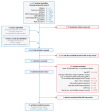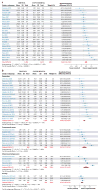Psychological Treatments for the World: Lessons from Low- and Middle-Income Countries
- PMID: 28482687
- PMCID: PMC5506549
- DOI: 10.1146/annurev-clinpsy-032816-045217
Psychological Treatments for the World: Lessons from Low- and Middle-Income Countries
Abstract
Common mental disorders, including depression, anxiety, and posttraumatic stress, are leading causes of disability worldwide. Treatment for these disorders is limited in low- and middle-income countries. This systematic review synthesizes the implementation processes and examines the effectiveness of psychological treatments for common mental disorders in adults delivered by nonspecialist providers in low- and middle-income countries. In total, 27 trials met the eligibility criteria; most treatments targeted depression or posttraumatic stress. Treatments were commonly delivered by community health workers or peers in primary care or community settings; they usually were delivered with fewer than 10 sessions over 2-3 months in an individual, face-to-face format. Treatments included common elements, such as nonspecific engagement and specific domains of behavioral, interpersonal, emotional, and cognitive elements. The pooled effect size was 0.49 (95% confidence interval = 0.36-0.62), favoring intervention conditions. Our review demonstrates that psychological treatments-comprising a parsimonious set of common elements and delivered by a low-cost, widely available human resource-have moderate to strong effects in reducing the burden of common mental disorders.
Keywords: common elements; global mental health; implementation processes; low- and middle-income countries; meta-analysis; psychological treatments; systematic review.
Figures







Similar articles
-
Psychological therapies for the treatment of mental disorders in low- and middle-income countries affected by humanitarian crises.Cochrane Database Syst Rev. 2018 Jul 5;7(7):CD011849. doi: 10.1002/14651858.CD011849.pub2. Cochrane Database Syst Rev. 2018. PMID: 29975811 Free PMC article.
-
Psychological and pharmacological interventions for posttraumatic stress disorder and comorbid mental health problems following complex traumatic events: Systematic review and component network meta-analysis.PLoS Med. 2020 Aug 19;17(8):e1003262. doi: 10.1371/journal.pmed.1003262. eCollection 2020 Aug. PLoS Med. 2020. PMID: 32813696 Free PMC article.
-
E-Health interventions for anxiety and depression in children and adolescents with long-term physical conditions.Cochrane Database Syst Rev. 2018 Aug 15;8(8):CD012489. doi: 10.1002/14651858.CD012489.pub2. Cochrane Database Syst Rev. 2018. PMID: 30110718 Free PMC article.
-
Antidepressants for pain management in adults with chronic pain: a network meta-analysis.Health Technol Assess. 2024 Oct;28(62):1-155. doi: 10.3310/MKRT2948. Health Technol Assess. 2024. PMID: 39367772 Free PMC article.
-
Psychological therapies for treatment-resistant depression in adults.Cochrane Database Syst Rev. 2018 May 14;5(5):CD010558. doi: 10.1002/14651858.CD010558.pub2. Cochrane Database Syst Rev. 2018. PMID: 29761488 Free PMC article.
Cited by
-
Schizophrenia Assessment, Referral and Awareness Training for Health Auxiliaries (SARATHA): Protocol for a Mixed-Methods Pilot Study in Rural India.Int J Environ Res Public Health. 2022 Nov 13;19(22):14936. doi: 10.3390/ijerph192214936. Int J Environ Res Public Health. 2022. PMID: 36429654 Free PMC article.
-
The unmet need for mental health support among persons with disabilities in Somalia: Principal correlates and barriers to access.Glob Ment Health (Camb). 2024 May 24;11:e73. doi: 10.1017/gmh.2024.66. eCollection 2024. Glob Ment Health (Camb). 2024. PMID: 39257679 Free PMC article.
-
Standardised Research Methods and Documentation in Cultural Adaptation: The Need, the Potential and Future Steps.Clin Psychol Eur. 2021 Nov 23;3(Spec Issue):e5513. doi: 10.32872/cpe.5513. eCollection 2021 Nov. Clin Psychol Eur. 2021. PMID: 36405674 Free PMC article.
-
From Formative Research to Cultural Adaptation of a Face-to-Face and Internet-Based Cognitive-Behavioural Intervention for Arabic-Speaking Refugees in Germany.Clin Psychol Eur. 2021 Nov 23;3(Spec Issue):e4623. doi: 10.32872/cpe.4623. eCollection 2021 Nov. Clin Psychol Eur. 2021. PMID: 36405676 Free PMC article.
-
Prevalence and prevention of suicidal ideation among asylum seekers in a high-risk urban post-displacement setting.Epidemiol Psychiatr Sci. 2022 Oct 17;31:e76. doi: 10.1017/S2045796022000579. Epidemiol Psychiatr Sci. 2022. PMID: 36245417 Free PMC article. Clinical Trial.
References
-
- Ali BS, Rahbar MH, Naeem S, Gul A, Mubeen S, Iqbal A. The effectiveness of counseling on anxiety and depression by minimally trained counselors: a randomized controlled trial. Am J Psychother. 2003;57:324–36. - PubMed
-
- Anderson T, Crowley ME, Himawan L, Holmberg JK, Uhlin BD. Therapist facilitative interpersonal skills and training status: a randomized clinical trial on alliance and outcome. Psychother Res. 2015;26:511–29. - PubMed
-
- Anderson T, McClintock AS, Himawan L, Song X, Patterson CL. A prospective study of therapist facilitative interpersonal skills as a predictor of treatment outcome. J Consult Clin Psychol. 2016;84:57–66. - PubMed
-
- Araya R, Flynn T, Rojas G, Fritsch R, Simon G. Cost-effectiveness of a primary care treatment program for depression in low-income women in Santiago, Chile. Am J Psychiatry. 2006;163(8):1379–87. - PubMed
Publication types
MeSH terms
Grants and funding
LinkOut - more resources
Full Text Sources
Other Literature Sources
Medical
Miscellaneous

